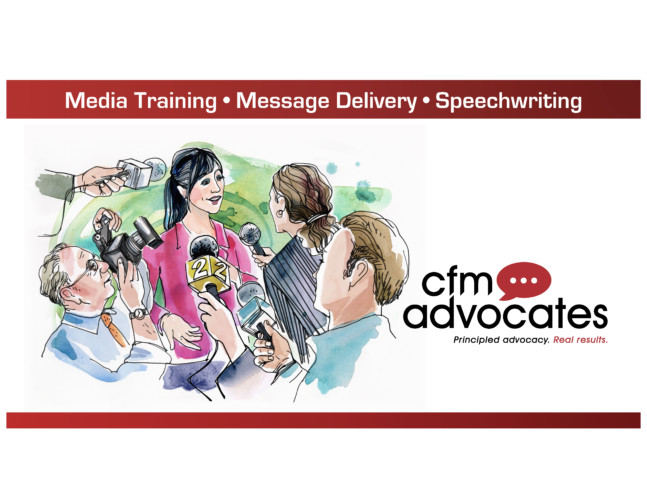
Media Interviews Are Performances, Not Conversations
Effective media training should help people say what they need to say – and know when to shut up.
Media interviews are performances, not conversations. That’s especially true in crisis response. Like an actor in a play, spokespersons have lines to deliver in the form of a key message. They are not on an improv stage.
Reporters, especially good ones, have techniques and tricks to get spokespersons off track. That’s their job. The spokesperson’s job is to stay on track and know when to shut up.
Spokespersons are often chosen because they are well-spoken, knowledgeable and even gregarious. They also should be selected for their ability to stay on message and resist the temptation to go off-the-record, which can be the equivalent of going into a ditch.
Disciplined media relations doesn’t have to mean buttoned-up communications. Internally, experienced spokespersons should advocate for key messaging based on verified, relevant information. They also should be a voice for choosing the appropriate tone and place to share that information.
The Role of The Key Message
A spokesperson needs a script centered on the key message. Crafting a key message is all about deciding the most important point to convey. There will be supporting data or explanations, but only one key message. If you have more than one, you risk having your main key message buried in news coverage below the rubble of other information.
Choosing the key message should be heavily influenced by what needs to be said and what the target audience wants to know. That should eliminate any consideration of happy-talk or diversionary key messages.
Once the key message has been identified, the next step is determining how to express it to capture the intent and match the moment. Word choices matter. The key message should be like the most memorable line in a play – something that reporters and audiences can’t miss or misconstrue.
The best key messages tie to actions, especially in a crisis response where reports and affected parties want to know what you are doing to stop or mitigate the crisis situation. Action-centered key messages should be framed in active, descriptive language.
Drafting key messages requires a bit of art as well as a lot of honesty. And crisis responses can’t wait, so advance preparation is essential.
Like an actor in a play, spokespersons have lines to deliver in the form of a key message. They are not on an improv stage.
The Value of Media Training
The core of advance preparation is media training. Competent media training includes reviewing the role of the news media, learning how to craft a key message and honing the skill to deliver a key message – and get off the stage.
Understanding the news media becomes more complicated by the day. In addition to traditional news outlets, there are cable broadcasters, online news sites, social media platforms, TikTok influencers, podcasters and independent journalists. There are also citizen “journalists” who can make news by capturing attention-gathering video on their smartphones. The mix of media tends to accelerate time lines for responding to crisis situations. The media mix also can influence in what form and forum a key message must be delivered.

Media training is essential for spokespersons to do their job competently and with confidence.
Crafting the key message demands an awareness of the audience as much as the media. If a helicopter goes down, the focus is on the fate of the pilot. If railcars carrying toxic chemicals derail, the focus is on the impact on a community.
Like any short statement, precise wording is critical to a key message. For maximum impact, it should be easy to deliver, easy to repeat and easy to remember.
The final element of media training is delivering the message with deft, focus and appropriate emotional energy. This is where the actor analogy applies. The spokespersons must speak the words and act the part to convey the key message.
Spokespersons also must prepare for interaction from reporters and people with cameras. Simulated interviews are helpful to experience the give-and-take of an interview. Stress-test simulations expose spokespersons to aggressive questioning and out-of-left-field questions. An important lesson is how to repeat, in the same or similar words, the key message while appearing responsive and helpful. It’s a difficult skill, but increasingly imperative in a more antagonistic and polarized media environment.
Learning How to Shut Up
No amount of media training can equip a spokesperson with the skill of knowing when to stop talking. It’s especially hard for spokespersons who are knowledgeable about the subjects they are talking about. They want to share, even though it may divert a conversation – and ultimately a news story – away from the key message they were assigned to deliver. It is better to leave an interview without saying everything you know or would like to share.
Shutting up is for many people quite unnatural. It takes self-awareness to know when to shut up and practice to learn ways to shut up.
Spokespersons may feel awkward circling back to a key message or tactfully evading a question that would take an interview on a detour. Awkwardness works both ways. Many reporters prefer to get a solid, quotable key message as opposed to a rambling commentary that is more confusing than informative.
If there are moments of silence in an interview, just wait for the next question. The spokesperson’s job is to deliver a clear, unmistakable key message, not fill the silence.

Relaxed breathing and a smile are important for spokespersons.
Practice What You Learn
As actors need to learn their lines and choreography, spokespersons also need to practice delivering a key message and knowing how and when to shut up. In truth, shutting up may be the hardest part of the knowledgeable spokesperson’s job.
No matter how much experience you have in responding to media inquiries and giving interviews, practice is required to be on the cutting edge of the interaction.
A few practice tips in addition to nailing down your key message delivery:
- Practice inhaling and exhaling as well as speaking
- Try out your key message on a friend or family member
- Remember to smile




